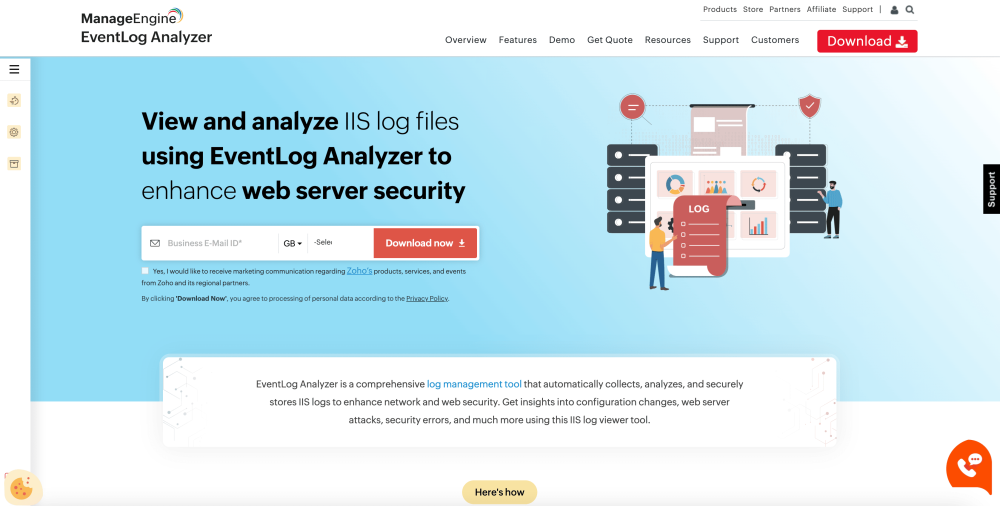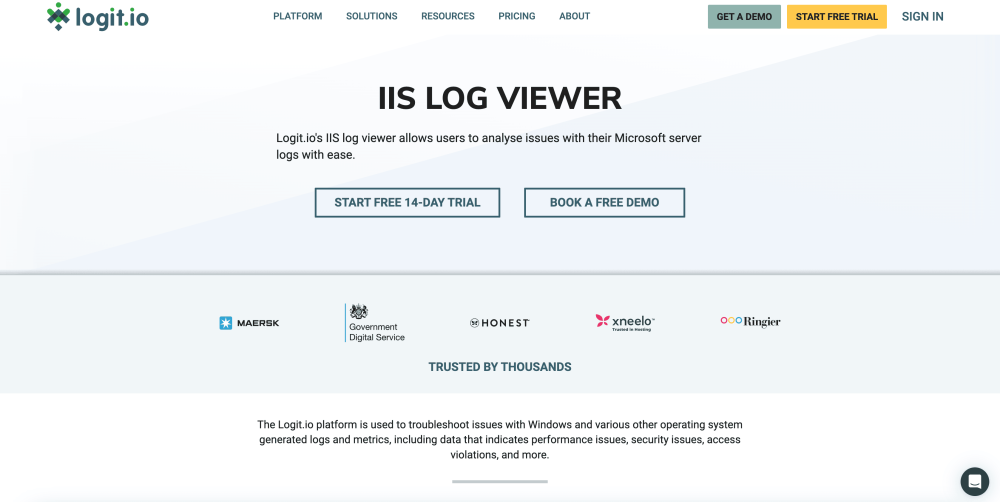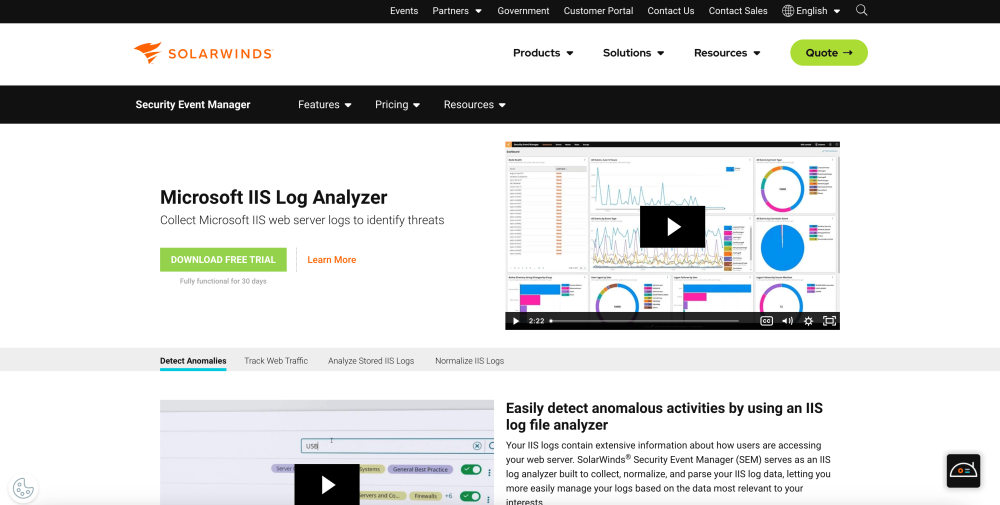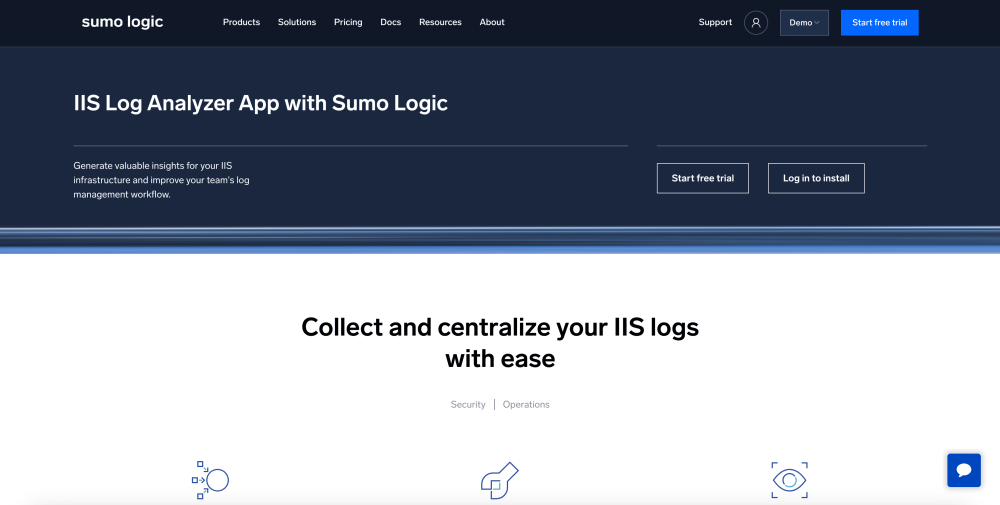Resources
7 min read
IIS (Internet Information Services) is a web server developed by Microsft, shipped as a part of the Windows Server services. It’s used to host and manage web applications and services. IIS is a particularly robust web server solution that is tightly integrated with the Windows operating system, making it a natural choice for organizations that rely on other Microsoft products. Also, it offers high performance and the ability to manage a significant number of simultaneous connections, making it suitable for hosting high-traffic websites and web applications. As well as this IIS offers a range of built-in security features that help protect web applications.
These benefits have led to the server solution being commonly used by numerous organizations, making it crucial for effective monitoring and analysis of IIS to be conducted. This is achieved through IIS logging, which involves the IIS web server recording detailed information about web server activity. This logging capability collects a wide range of data points for each client request made to the server, offering crucial insights for teams and organizations.
However, IIS log files can be extensive and complex, which makes it difficult to conduct effective monitoring and analysis. The solution to this issue is to utilize an IIS log viewer. With an IIS log viewer, the process of examining these logs is streamlined by offering a user-friendly interface that makes it simple to search, filter, and interpret the data. This can lead to time saved and a reduction in the likelihood of missing important information.
Contents
What are IIS Logs?
IIS logs, or Internet Information Services logs, are detailed logs generated by Microsoft's web server software. These logs capture a broad variety of data about the interactions between the web server and its clients, offering invaluable insights for administrators, developers, and security professionals. IIS logs typically include information such as the date and time of requests, client IP addresses, user agent strings, HTTP methods, requested URLs, response status codes, and the time taken to process each request.
IIS logs are vital for tracking web server performance, diagnosing issues, examining traffic patterns, and recognizing potential security threats. By offering an extensive record of web server activity, IIS logs play a crucial role in maintaining the reliability, security, and performance of web applications.
What is an IIS Log Viewer?
An IIS log viewer is a tool designed to aid administrators and developers in examining and interpreting the log files produced by Microsoft's Internet Information Services (IIS) web server. The log viewer offers a user-friendly interface for navigating through the extensive data captured in IIS logs, making it simpler to search for specific events, filter data based on criteria such as date or status code, and visualize trends or patterns in server activity.
Why Monitor IIS Logs?
By opting to monitor IIS logs you can gain numerous benefits. An example of these benefits is enhanced security. Monitoring IIS logs can help attain great security in providing web traffic insights and activities of the users. Some of the crucial data captured by these logs include IP addresses, methods of request, and response codes, which make it easy to identify suspicious activities and take immediate action. Such analysis of IIS logs will help detect potential threats of SQL injection attempts, unauthorized access, and DDoS attacks at an early stage for effective remediation measures and reduction of risks from breaches.
Monitoring IIS logs is also very important to meet compliance and help with audit processes. A lot of regulatory frameworks require logging of user activities and access to sensitive information; examples include GDPR, HIPAA, and PCI DSS. For that, IIS logs contain full information on all interactions made with web applications to guarantee an organization meets such standards. Log reviews and regular audits help to confirm if the security policies are followed and if any deviations are corrected forthwith.
Lastly, another key advantage brought by monitoring IIS logs is how it may improve web application performance. IIS logs record the details of how long request processing takes, the time it takes for responses from servers, and the usage of various resources. This could help administrators determine which areas are potential bottlenecks, such as slow page loading, inefficient queries, or high-latency network segments. In this way, data-driven optimization efforts can be very targeted to fine-tune configurations, optimize code, or upgrade hardware resources. This can help in faster response times and a smoother user experience.
The Benefits of Centralizing IIS Log File Locations
Aggregating IIS log file locations into a single view offers a variety of benefits when it comes to effective log management and analysis. First, it is easier to access and retrieve consolidated IIS logs from one location, hence easing the monitoring process. Instead of sifting through different directories in multiple servers, administrators can view these logs from one central repository, saving valuable time and effort. This centralized approach ensures that all the relevant log data—be it access, error, or security logs—will be readily available for analysis and troubleshooting tasks.
Furthermore, centralizing IIS log file locations also improves consistency and standardization of data across the IT infrastructure. Standardization of log file storage structure and naming conventions can help dispel inconsistencies and variances that may occur from decentralized ways of logging by an organization.
Finally, centralization of IIS log files enhances scalability and can be applied to log management operations. As organizations scale their web infrastructure to handle increased traffic and general growth of service offerings, managing logs at a host distributed across thousands of servers becomes ever more challenging. Such centralization allows organizations to scale their log management infrastructure much more easily, without many changes or reconfigurations. It enables seamless integration of new servers into the logging environment and the tweaking of log retention policies without much hassle, ensuring access and manageability of log data as the organization grows.
Why Use An IIS Log Viewer
A common reason users opt for an IIS log viewer is that it simplifies the process of analyzing particularly complex log files. However, this is not the only benefit that can be gained from using the tool. Firstly, it offers organizations enhanced troubleshooting. An IIS log viewer assists in promptly recognizing and diagnosing issues by identifying error patterns, failed requests, and performance bottlenecks. With features such as sorting and filtering, users can pinpoint specific events or anomalies that may cause problems, leading to faster resolution of issues.
Another key reason to utilize an IIS log viewer is that users can attain insights into the performance of their web applications. An IIS log viewer can aid in recognizing slow requests, high traffic times, and other performance-related metrics. This information is vital for enhancing server performance, optimizing user experience, and planning for capacity increases.
How Can an IIS Log Viewer Improve Network Security?
Enhancing the security posture of your network is crucial for all organizations and with an IIS log viewer, you can further improve this. The tool offers a streamlined and efficient means to examine and track server activity, helping identify and react rapidly to potential security threats. Enabling detailed inspection of log entries means users can detect unusual patterns, such as repeated failed login attempts and suspicious IP addresses that may indicate a cyber attack. The ability to filter, sort, and visualize log data facilitates the rapid identification of security incidents, enabling timely intervention.
The Leading IIS Log Viewer Tools
ManageEngine
 ManageEngine’s EventLog Analyzer offers the ability to view and analyze IIS log files to improve web server security. With this tool, you can attain insights into configuration changes, web server attacks, and security errors. The tool can automatically collect IIS logs from web server files and store them in its central server.
ManageEngine’s EventLog Analyzer offers the ability to view and analyze IIS log files to improve web server security. With this tool, you can attain insights into configuration changes, web server attacks, and security errors. The tool can automatically collect IIS logs from web server files and store them in its central server.
Logit.io
 Logit.io offers an IIS platform that is a cost-effective and powerful log management and visualization tool that offers everything engineers need to monitor and troubleshoot IT infrastructure. With our solution, you can examine IIS logs in real time with reports, custom alerts, dashboards, and views. You can gain from visualizing your logs with an intuitive Kibana or Grafana-backed dashboard from which your team can examine and visualize logs from multiple servers.
Logit.io offers an IIS platform that is a cost-effective and powerful log management and visualization tool that offers everything engineers need to monitor and troubleshoot IT infrastructure. With our solution, you can examine IIS logs in real time with reports, custom alerts, dashboards, and views. You can gain from visualizing your logs with an intuitive Kibana or Grafana-backed dashboard from which your team can examine and visualize logs from multiple servers.
If you’re interested in finding out more about Logit.io’s IIS Log Viewer and it’s extensive capabilities, don’t hesitate to contact us or begin exploring the platform for yourself with a 14-day free trial.
SolarWinds
 The next leading IIS log viewer tool is provided by SolarWinds, specifically the Security Event Manager. Here, you can run out-of-the-box rules and alerts to detect new and unique errors. As well as this, with this tool you can search for references to system tables, functions, views, and schemas, and highlight patterns in your web traffic with the ability to run reports to visualize data in real-time for general or specific events.
The next leading IIS log viewer tool is provided by SolarWinds, specifically the Security Event Manager. Here, you can run out-of-the-box rules and alerts to detect new and unique errors. As well as this, with this tool you can search for references to system tables, functions, views, and schemas, and highlight patterns in your web traffic with the ability to run reports to visualize data in real-time for general or specific events.
Sumo Logic
 With Sumo Logic you can utilize its IIS Log Analyzer App to aggregate and centralize IIS logs. The key features of the Sumo Logic solution are log centralization, real-time analytics, continuous monitoring and alerts, intuitive dashboards and reports, and advanced machine learning. With this tool, you can view common IIS operations details including requests by server, response throughputs, and response codes over time, as well as others.
With Sumo Logic you can utilize its IIS Log Analyzer App to aggregate and centralize IIS logs. The key features of the Sumo Logic solution are log centralization, real-time analytics, continuous monitoring and alerts, intuitive dashboards and reports, and advanced machine learning. With this tool, you can view common IIS operations details including requests by server, response throughputs, and response codes over time, as well as others.
If you've enjoyed this article why not read The Importance of Security Log Management or What is Server Monitoring next?
